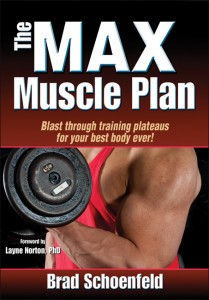
Recent Blog Posts
July 20, 2013
M.A.X Muscle Warm-Up

Writing a book is a lengthy, arduous process. To do it right involves a great deal of planning. You need to map out everything that needs to be covered and decide on the best way to organize this information into a cohesive, readable format. A diligent author spends countless hours contemplating these complexities before a single word makes it to the page. But no matter how attentive you are to detail, there are always some things you somehow miss that ultimately become apparent once the book is released. The best you can do at this point is to address any omissions ex post facto.
Based on reader feedback and questions, it has come to light that I made such an omission in my book, The M.A.X. Muscle Plan, with respect to warming up prior to training. In retrospect, this is not something that I should have taken for granted. A warm-up heightens blood flow to muscles, enhances speed of nerve impulses, increases energy substrate delivery to working muscles as well oxygen release from hemoglobin and myoglobin, and reduces the activation of energy for cellular reactions and muscle viscosity (Thacker et al. 2004). Suffice to say, it’s an important component of a workout. This post therefore will seek to rectify the oversight and address my recommendedations for the M.A.X. Muscle warm-up.
A warm-up can be divided into two distinct components: general and specific. The general warm-up – which involves performing a brief bout of low-intensity, large muscle group aerobic-type exercise – should be included in all three M.A.X. Muscle mesocycles (i.e. strength, metabolic conditioning, and hypertrophy). The purpose of the general warm-up is to elevate core temperature and increase blood flow. This has implications not only for injury prevention, but for performance as well. In fact, there is evidence that combining a general warm-up with a specific warm-up increases maximal strength to a greater degree than peforming a specific warm-up alone (Abad et al. 2011).
Virtually any cardiovascular activity can be used for the general warm-up. Modalities such as the stationary bike, stair climber, or treadmill are fine, as are most calisthenic-type exercises (such as jumping jacks, high steps). Choose whatever activity you desire as long as the basic objective is met.
As previously noted, the intensity for the general warm-up should be low. To gauge intensity, I like to use a rating of perceived exertion (RPE) scale. My preference is the Category-Ratio RPE Scale, which grades perceived effort on a range of 0-10 (where 0 is lying on your couch and 10 is an all-out sprint). Aim for an RPE of around 5, which for most would be a moderate walk or slow jog. Five to ten minutes is all you need – just enough to break a light sweat. Your resources should not be taxed, nor should you feel tired or out of breath either during or after performance. If so, cut back on the intensity. Remember, the goal here is merely to warm your body tissues and accelerate blood flow — not to achieve cardiovascular benefits or reduce body fat.
The specific warm-up augments the general warm-up. It serves to enhance neuromuscular efficiency in performing a given exercise. To optimize benefits, the exercises used in the specific warm-up should be as similar as possible to the actual activities in the workout. For example, if you are going to perform a bench press, then the specific warm-up would ideally involve performance of light sets of bench presses. In this way, the neuromuscular system gets to “rehearse” the movement before it is performed higher levels of intensity. Specific warm-up sets should always be stopped well short of fatigue – the focus here is to facilitate performance of the heavier sets.
For the M.A.X Strength Phase, I recommend at least a couple of specific warm-up sets per exercise. Since this phase employs a total body routine with very heavy loads (>85% 1RM), it is important that each exercise include specific warm-up sets. As a general rule the first set should be performed at ~40-50% of 1RM and the second set at ~60-70% 1RM. Eight to ten reps is all that is needed in these sets –any more than this is superfluous. Thereafter, you’re then ready to plow into your working sets.
For the M.A.X Hypertrophy Phase, I recommend performing a specific warm-up prior to the first exercise for each muscle group only. Since this is a split-routine where multiple exercises are performed per body part, the benefits achieved from the specific warm-up on the intial movement will carry over to the other exercises for the subsequent exercises for that muscle group. Additional warm-up sets can actually be detrimental since they can hinder generation of metabolic stress, which is a desired outcome in this phase.
Specific warm-up sets are not necessary in the M.A.X Metabolic Phase. In this phase you’re already using light weights and the initial repetitions of each working set therefore serve as “rehearsal” reps. What’s more, performance of warm-up sets is counterproductive to the goal of maximizing training density to bring about desired metabolic adaptations.
Hopefully this addresses the feedback and questions I’ve received on the topic. I’ll look to cover some additional questions I’ve received in future posts. In the meantime, keep the comments coming!
Brad
References
- Abad CC, Prado ML, Ugrinowitsch C, Tricoli V, Barroso R. Combination of general and specific warm-ups improves leg-press one repetition maximum compared with specific warm-up in trained individuals. J Strength Cond Res. 2011 Aug;25(8):2242-5.
- Thacker SB, Gilchrist J, Stroup DF, Kimsey CD Jr. The impact of stretching on sports injury risk: a systematic review of the literature. Med Sci Sports Exerc. 2004 Mar;36(3):371-8
October 29, 2012
MAX Muscle Podcast
Here is a podcast that I did with my publisher, Human Kinetics, discussing aspects of my new book, The MAX Muscle Plan. It’s a wide-ranging interview where I delve into topics such as:
Click on the arrow below to listen to the podcast:
September 28, 2012
The MAX Muscle Plan

I’m thrilled and excited to announce the release of my new book, The MAX Muscle Plan. The book outlines a 6-month periodized program to maximize muscle development. It is the culmination of many years of research and experience, blending the science and art of exercise program design for optimal gains. Every rep, set, and rest interval is mapped out, with complete discussions as to how to individualize the routine for best results. There also is a entire chapter devoted to nutrition for muscle growth–an essential aspect of any muscle-building program. A big thanks to Layne Norton for writing the forward to the book, and to Alan Aragon for reviewing the nutrition chapter.
Here is a link to check out the book on Amazon.com, who is offering it at a significant discount. If you have any questions about it let me know!





 Entries (RSS)
Entries (RSS)



